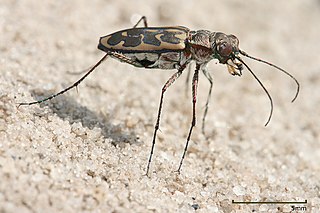
Tiger beetles are a family of beetles, Cicindelidae, known for their aggressive predatory habits and running speed. The fastest known species of tiger beetle, Rivacindela hudsoni, can run at a speed of 9 km/h, or about 125 body lengths per second. As of 2005, about 2,600 species and subspecies were known, with the richest diversity in the Oriental (Indo-Malayan) region, followed by the Neotropics. While historically treated as a subfamily of ground beetles (Carabidae) under the name Cicindelinae, several studies since 2020 indicated that they should be treated as a family, the Cicindelidae, which are a sister group to Carabidae within the Adephaga.

Hydrophilidae, also known colloquially as water scavenger beetles, is a family of beetles. Aquatic hydrophilids are notable for their long maxillary palps, which are longer than their antennae. Several of the former subfamilies of Hydrophilidae have recently been removed and elevated to family rank; Epimetopidae, Georissidae, Helophoridae, Hydrochidae, and Spercheidae. While the majority of hydrophilids are aquatic, around a third of described species are terrestrial, mostly belonging to the subfamily Sphaeridiinae.
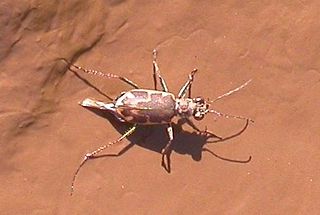
The Salt Creek tiger beetle is a critically endangered subspecies of tiger beetle endemic to the saline wetlands of northern Lancaster County, Nebraska, adjacent to and immediately to the north of the city of Lincoln, Nebraska. It is a predatory insect, using its mandibles to catch other insects. The beetle is one of the rarest insects in North America; surveys showed that 194 adults existed in 2009, down from 263 in 2008, and 777 in 2000. However, efforts are continuing to boost the population, which in 2013 numbered 365 beetles: one beetle for each day in a regular year. The adult beetles can move very fast to catch their prey.

Cicindela, commonly known as common tiger beetles, are generally brightly colored and metallic beetles, often with some sort of patterning of ivory or cream-colored markings. They are most abundant and diverse in habitats very often near bodies of water with sandy or occasionally clay soils; they can be found along rivers, sea and lake shores, sand dunes, around dry lakebeds, on clay banks, or woodland paths.
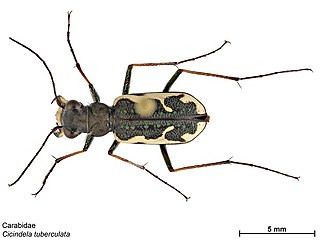
Neocicindela tuberculata is a species of tiger beetle in the family Cicindelidae, endemic to New Zealand. Its common names include common tiger beetle, moeone, and papapa, and in its larval stage penny doctor, butcher boy, kapuku, kui, kurikuri, moeone, and muremure. Neocicindela tuberculata was the first carabid beetle described from New Zealand. The species can run as fast as 5 miles per hour and are considered to be the fastest running beetles. Adult species prefer clay banks in summer and are good predators when in comes to insects.
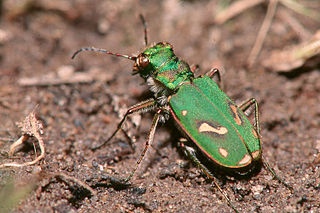
Cicindela ohlone, the Ohlone tiger beetle, is endemic to California. It was discovered in 1987 and named and described in 1993. C. ohlone is most closely related to Cicindela purpurea.
Cicindela columbica is a species of beetle in the tiger beetle family, Cicindelidae, known commonly as the Columbia River tiger beetle. It is endemic to Idaho in the United States.
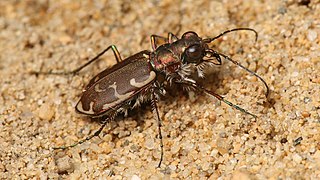
Cicindela repanda, commonly known as the bronzed tiger beetle or common shore tiger beetle, is a species of tiger beetle that is 10–13 millimetres (0.39–0.51 in) long and lives in most of North America. It has a small labrum with one tooth and a coppery, hairy pronotum. The shoulder marking usually touches the middle band. It is most often seen in spring and summer, and it lives in sand, gravel, or clay soil. It feeds on many species of insects and even some fruit. The species has a two-year life cycle. It can be found across sand dunes around the Great Lakes. The species comprises three subspecies: C. repanda repanda, C. repanda novascotiae, and C. repanda tanneri.

Cicindela hirticollis is a species of tiger beetle that is commonly found in sand bars and sandy beaches of North America. It is medium-sized, is about 2–14 mm (0.08–0.55 in) long, and is active in the summer. The dorsal surfaces of the head, prothorax, and elytra are dark brown. The elytral markings are very light-colored cream or white. The species' common names are hairy-necked tiger beetle and moustached tiger beetle. Its population is in decline.

The pictured rove beetle is a wingless rove beetle which lives on the sandy beaches of the West Coast of the United States from southern Alaska to Baja California. It is nocturnal, emerging at night from temporary sand burrows to feed on beach hoppers (Orchestoidea).
Pheropsophus aequinoctialis is a species of ground beetle from Yucatán and Central and South America that feeds as larvae on the eggs of mole crickets but as an adult is a generalist feeder.
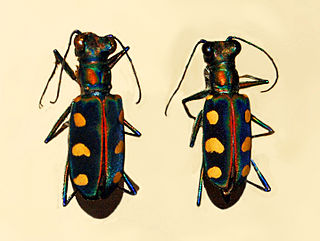
Cicindela aurulenta, common name blue-spotted or golden-spotted tiger beetle, is a beetle of the family Cicindelidae.

Cicindela albissima, commonly called the Coral Pink Sand Dunes tiger beetle is a species of tiger beetle endemic to Coral Pink Sand Dunes State Park in southern Utah, United States. It was originally described by Rumpp in 1962 as the subspecies Cicindela limbata albissima, but mitochondrial DNA, along with the species' morphological and geographical distinctiveness, have shown that it is a separate species. C. albissima can be distinguished from other Cicindela species by its restricted range and lack of pigmentation on its elytra.

Cicindela patruela, the northern barrens tiger beetle, is a species of tiger beetle found in eastern North America. Due to their specific habitat requirements as well as human involvement, populations of this species have declined significantly in several regions, including most of New England, Ontario, and Quebec.

Cicindela arenicola is a species of tiger beetle in the genus Cicindela. It was first described in 1967. Its common names include St. Anthony Dune tiger beetle and Idaho Dunes tiger beetle.
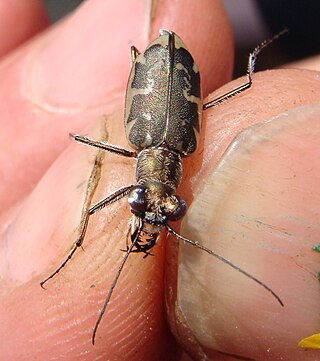
Ellipsoptera puritana, the puritan tiger beetle, is a species of flashy tiger beetle in the family Cicindelidae. It is found in North America. Puritan tiger beetles are found in sandy beaches and rocky cliffs along rivers in Massachusetts, Maryland, and Connecticut. Little is known about this species due to its small geographic range and quickly disappearing populations.

Cicindela tranquebarica, the Oblique-lined tiger beetle, is a species of flashy tiger beetle in the family Cicindelidae that is found in North America. It appears in various colors, but it is most commonly known for its compound eyes. The beetle can range from 11 mm to 16 mm, and females are often observed to be slightly longer than males. This beetle is sensitive to temperature changes and performs stilting to help with temperature regulation. They typically display a variety of social behaviors and are a strong flier.

Habroscelimorpha dorsalis dorsalis, commonly known as the northeastern beach tiger beetle, is the largest subspecies of eastern beach tiger beetle. In 2012, Cicindela dorsalis dorsalis was reclassified under the name Habroscelimorpha dorsalis dorsalis, but the names are used synonymously in recently published literature. Fitting to its common name, the northeastern beach tiger beetle dwells along the U.S. northeast coast in small sand burrows. The beetle is diurnal and can be spotted by its light tan coloring with dark lines and green hues on its thorax and head.

Rivacindela hudsoni is an Australian species of the family Cicindelinae or "tiger beetle" and is the fastest running insect. The genus Rivacindela is contentiously treated as a subgenus of the broader Cicindela and are typically found in salty habitats such as dry salt lakes and salt streams. The species was discovered in South Australia and described in 1997, with an adult form of approximately 20–21mm in length and a running speed of 2.49 m/s, or 120 body lengths per second.
Cicindela (Cicindelidia) floridana, or the Miami tiger beetle, is a species of endangered tiger beetle in the tribe Cicindelini. It is restricted to the Miami area in Southern Florida, and is one of the rarest species of tiger beetle in the United States.




















